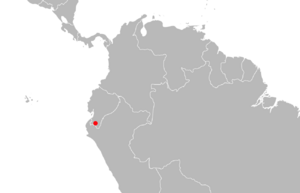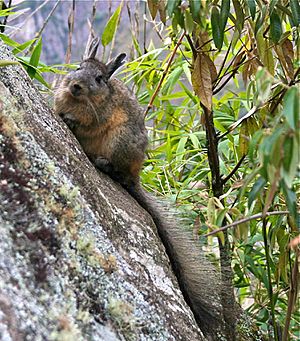Lagidium ahuacaense facts for kids
Quick facts for kids Lagidium ahuacaense |
|
|---|---|
| Scientific classification | |
| Genus: |
Lagidium
|
| Species: |
ahuacaense
|
 |
|
The Lagidium ahuacaense is a type of rodent known as a mountain viscacha. It lives in southern Ecuador. Scientists first saw this animal in 2005. They officially described it as a new species in 2009.
This viscacha lives over 500 kilometers (310 miles) north of where other mountain viscachas were known to live. Only one group of these animals is known to exist. They live on rocky parts of Cerro El Ahuaca, a mountain in southern Ecuador. There are only a few dozen of these animals left. They are in danger from fires and cows eating their food. Because of this, experts think they should be listed as critically endangered.
Discovery and Naming
Scientists first found L. ahuacaense in July 2005. This was on Cerro El Ahuaca in Ecuador. It was a big surprise because no other mountain viscachas were known to live so far north. The closest known group was over 500 kilometers (310 miles) away in central Peru.
In 2006, scientists Florian Werner, Karim Ledesma, and Rodrigo Hidalgo wrote about this discovery. They thought it might be the Peruvian species Lagidium peruanum. But they also thought it could be a new species.
Three years later, Karim Ledesma, Florian Werner, Ángel Spotorno, and Luis Albuja studied the animals more closely. They looked at their bodies and their DNA. They found enough differences to say it was a new species. They named it Lagidium ahuacaense. The name "ahuacaense" comes from Cerro de Ahuaca, the mountain where it lives. They suggested calling it the "Ecuadorean mountain viscacha."
This was the fourth species of Lagidium to be described. Other species include L. peruanum, L. viscacia, and L. wolffsohni. All Lagidium species belong to the Chinchillidae family. This family also includes the plains viscacha and chinchillas. The DNA of L. ahuacaense is quite different from other Lagidium species. This shows it is unique.
What it Looks Like

The L. ahuacaense is a medium-sized animal. It has soft, gray-brown fur. It also has a very long tail. A black stripe runs down the middle of its back. Its long whiskers are mostly dark brown. It also has thick, brown hairs above its eyes. Its ears are covered with dark skin.
The fur on its belly is creamy white. Its front feet are covered in brown fur and are much shorter than its back feet. The back feet have a mix of brown and cream hairs, along with some dark brown hairs. Both its front and back feet have four toes. These toes have small, curved claws. The bottoms of its feet are bare.
Its tail is very hairy. The hairs on top are longer than those underneath. The top of the tail is gray-brown near the body. In the middle, it's light to medium brown mixed with cream. The tip of the tail is reddish-brown. The underside of the tail is dark brown.
One L. ahuacaense that was measured was about 403 millimeters (15.9 inches) long from head to body. Its tail was 400 millimeters (15.7 inches) long. Its back foot was 85 millimeters (3.3 inches) long. Its ear was 60 millimeters (2.4 inches) long. This animal weighed about 2.03 kilograms (4.5 pounds).
The skull of L. ahuacaense is long and strong. Its cheekbones are wide. The front part of its skull is wider than in some other viscacha species. It has large, white front teeth that have grooves. Its back teeth grow continuously throughout its life.
Where it Lives and How it's Protected
The L. ahuacaense is only found on Cerro El Ahuaca. This is a steep, rocky mountain near Cariamanga in southern Ecuador. It lives at heights between 1,950 and 2,480 meters (6,400 and 8,140 feet). It prefers to live near rocky areas.
The plants in its habitat are mostly molasses grass. These viscachas eat plants, and you can see signs of their feeding on the mountain. The area they live in on Cerro El Ahuaca is about 120 hectares (300 acres). The total number of these animals might be only a few dozen. There are no other suitable places nearby for them to live. However, there might be other groups of these viscachas in southern Ecuador or northern Peru that haven't been found yet.
This species is in danger from fires. People use fires to clear land for crops nearby. These fires often get out of control and burn parts of the viscacha's home on the mountain. They also face competition for food from cows that graze in the area. Luckily, local people do not know about this animal, so it is not hunted.
Because there are so few of them and they live in such a small area, scientists like Ledesma recommend that L. ahuacaense be listed as critically endangered by the IUCN Red List. They also suggest that people take immediate action to protect the viscachas on Cerro El Ahuaca. More research is also needed to learn about their lives.
See also
 In Spanish: Arnejo para niños
In Spanish: Arnejo para niños

